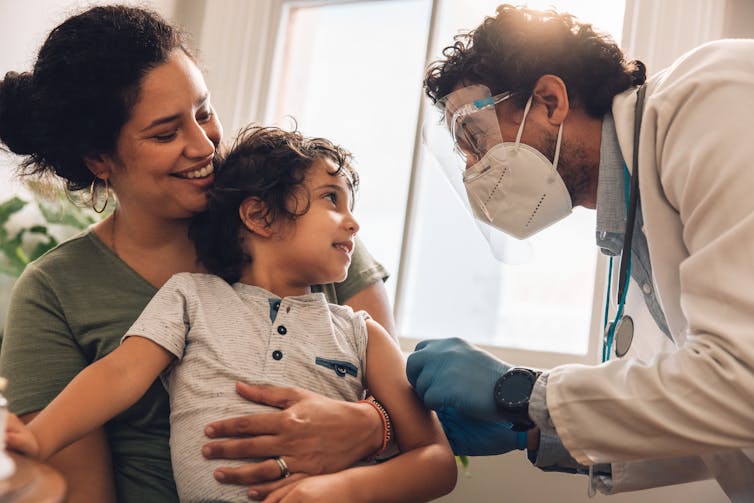
The COVID pandemic has disrupted many areas of routine healthcare including, importantly, childhood vaccination.
The pandemic saw levels of essential childhood immunisations decline in more than 100 countries around the world, leading to outbreaks of infectious diseases such as yellow fever, cholera, diphtheria and polio.
There are many reasons for this, including issues with supply, restricted access to services, and in some areas, factors unrelated to the pandemic such as conflict. But one contributor that’s important to recognise and address is vaccine hesitancy.
In 2019, the World Health Organization (WHO) identified vaccine hesitancy as one of its top ten threats to global health. It appears this threat has only increased since the COVID pandemic.
A perfect storm for infectious diseases
While COVID has had significant consequences for global vaccination rates, there are signs that, in some countries and for some diseases, there has been a longer-standing stalling or even decline in vaccine coverage.
In England, for example, childhood vaccination coverage generally plateaued from around 2011 and declined from around 2014.
Read more: How to dissuade parents from believing in anti-vaxxer conspiracy theories
Rates of many infectious diseases declined at the height of the pandemic due to widespread social distancing measures, but cases have since started to increase. For example, the number of countries with significant measles outbreaks rose by 50% between 2020–21 and 2022–23. Cases have also recently occurred in some high-income countries with historically good vaccine coverage.
Measles, which can be deadly for unvaccinated children, is highly contagious and spreads very quickly. It’s often regarded as the “canary in the coalmine” – if measles cases are spreading, this is a warning that other disease outbreaks might spring up where there are gaps in vaccination coverage.
The combination of reduced vaccine coverage, overstretched healthcare systems, and the return to pre-pandemic levels of social contact have created a perfect storm for infectious disease rates to rise. Growing vaccine hesitancy is only likely to make this issue worse.

A recent report from Unicef shows that confidence in the importance of vaccines for children is lower now than before the pandemic in many countries.
And while overall confidence has declined, some drops have been seismic. In South Africa and Japan, for example, the proportion of people confident in the importance of childhood vaccines dropped by approximately one-third during the pandemic.
Even in countries like the US where overall confidence in the importance of childhood vaccines remains relatively high, concerns over potential side-effects have grown over the past two-to-three years.
What drives vaccine hesitancy?
One of the main factors leading to hesitancy towards COVID vaccines specifically has been concern that the vaccines were developed too quickly. However, we know that COVID vaccines are safe and effective.
In our research on attitudes to COVID vaccines, my colleagues and I found that concerns over side-effects, distrust in government and a belief in conspiracy theories all increased hesitancy. And hesitancy around COVID shots could also lead to hesitancy “spillover” for other vaccines.
The Unicef report similarly notes that reduced trust in authorities, as well as the proliferation of misinformation and conspiracy theories on social media, are growing challenges to public perceptions of vaccines.
Misinformation is a vector of disease
Over the course of the pandemic, we’ve seen widespread misinformation around the safety of COVID vaccines, which has unsurprisingly been linked to reduced confidence in the vaccines.
The problem with misinformation is how intractible it can be. Myths, conspiracies or falsehoods about vaccines can be hard to shake. For example, the infamous 1998 study falsely linking MMR vaccines to autism – long since retracted and completely debunked – still has negative effects 25 years later. This can be seen in the conspiracy theories espoused by prominent anti-vax voices in high-income countries like the US, and in hesitancy felt by ordinary parents in much less wealthy countries such as Kyrgyzstan.
How do we increase vaccine confidence?
Vaccinations prevent 4–5 million deaths a year. But according to the WHO, a further 1.5 million deaths could be avoided if global coverage of vaccinations improved. Reducing vaccine hesitancy is one part of the solution.
For example, a study from Japan predicted that vaccine hesitancy in relation to the HPV vaccine between 2013 and 2019 could lead to approximately 5,000 deaths from cervical cancer.
Read more: Lack of trust in public figures linked to COVID vaccine hesitancy – new research
To address vaccine hesitancy, we need to tackle the root causes. We can look to the “three Cs model”, which suggests we need to maximise convenience (making vaccines easy to access) and minimise complacency by adequately communicating the risks of diseases. The third “C” is confidence.
Crucially, to increase confidence, we need to combat vaccine hesitancy caused by misinformation. One way to do this is through “inoculation” or “prebunking”, where people are exposed to small amounts of false information – for example, in online games or social media videos. This helps bolster their “immunity” to misinformation by enhancing their critical assessment skills.
Another way is to use social media to combat misinformation by investing in the promotion of accurate information. Organisations such as the WHO and Unicef will play a key role in building confidence globally.
In short, alongside efforts to catch kids up with vaccine doses missed during the pandemic, we also need to tackle misinformation. Otherwise, vaccine hesitancy will remain one of the greatest threats to global health for years to come.
Simon Nicholas Williams has received funding from Senedd Cymru, Public Health Wales and the Wales Covid Evidence Centre for research on COVID-19, and has consulted for the World Health Organization. However, this article reflects the views of the author only, in his academic capacity at Swansea University, and no funding or organizational bodies were involved in the writing or content of this article.
This article was originally published on The Conversation. Read the original article.







